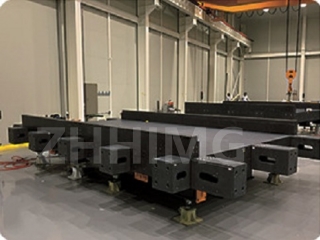Granite is a popular choice for optical waveguide positioning device products due to its unique combination of physical properties that make it an ideal material for precision mechanical systems. Compared to metals, granite has several advantages that make it superior in this application. In this article, we explore why granite is a good choice for optical waveguide positioning device products.
1. Excellent Stability
Granite is a naturally occurring form of igneous rock that is composed of quartz, mica, and feldspar. It is known for its excellent stability, which makes it an ideal material for use in precision mechanical systems. Granite has a low coefficient of thermal expansion, meaning it does not expand or contract significantly in response to changes in temperature. This is particularly important for optical waveguide positioning devices, which require a high degree of stability to maintain accurate position and alignment.
2. High Density
Granite is a dense material, which means it has a high weight-to-volume ratio. This makes it very stable and resistant to vibrations and external forces that could shift its position. The high density also makes it an ideal material for use in the construction of the optical waveguide positioning device product, as it can support the weight of the components without bending or flexing.
3. Low Thermal Conductivity
Granite has a low thermal conductivity, which means it does not transfer heat easily. This is important for optical waveguide positioning devices, which generate heat during operation. The low thermal conductivity of granite helps to insulate the components from the heat generated, preventing changes in temperature that could affect the position and alignment of the waveguides.
4. High Resistance to Corrosion
Granite is highly resistant to corrosion, which makes it an ideal material for use in optical waveguide positioning devices that must operate in harsh environments. The resistance to corrosion prevents the components from deteriorating over time, maintaining the high precision and accuracy of the device.
5. Aesthetically Pleasing
Finally, granite has an attractive appearance that makes it aesthetically pleasing. This is important for products that are used in laboratory settings or other locations where appearance is important. The use of granite in optical waveguide positioning devices adds a touch of elegance and sophistication to the product, making it appealing to users.
In summary, there are several advantages to choosing granite as the material for optical waveguide positioning device products. Granite offers excellent stability, high density, low thermal conductivity, high resistance to corrosion, and an attractive appearance. These properties make it an ideal material for use in precision mechanical systems that require high precision and accuracy.
Post time: Dec-04-2023

